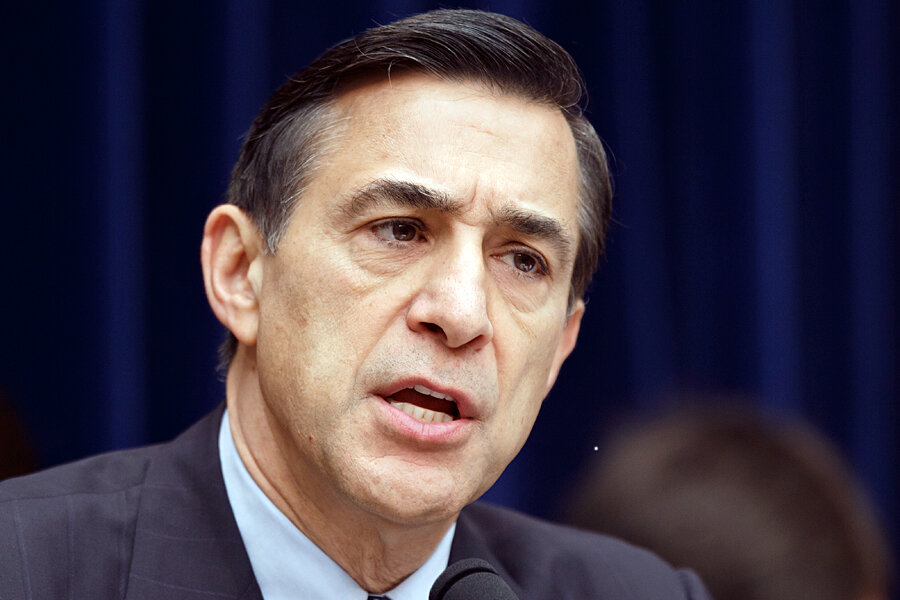Does newly released Benghazi e-mail prove White House misled America?
Loading...
| Washington
Does a now-public Benghazi e-mail prove that the Obama White House covered up the real motivations of terrorists who killed four Americans in the attack on US diplomatic buildings in Libya?
That's a hot issue in US politics at the moment, after the release of the message by Judicial Watch, a right-leaning group that just obtained a batch of Benghazi-related documents as the result of a Freedom of Information Act request.
The e-mail message in question was written by Ben Rhodes, President Obama's deputy national security adviser for strategic communications, in the immediate aftermath of the Sept. 11, 2012, incident. It dealt with preparing his then-boss, National Security Adviser Susan Rice, for a round of appearances on Sunday news shows to discuss Benghazi details.
Among other things, the e-mail stressed that Ms. Rice should say the attacks were prompted by a YouTube video insulting to Muslims that had sparked widespread protests in the Middle East. Rice’s goal should be to “underscore that these protests are rooted in an Internet video, and not a broader failure of policy,” Mr. Rhodes wrote.
Another goal should be to “reinforce the President and Administration’s strength and steadiness in dealing with difficult challenges,” according to Rhodes.
Many Republicans have long said that the administration purposely downplayed evidence that the attacks were a pre-planned assault by Islamist terrorists. To admit that point would have been to contravene the White House insistence that Al Qaeda was on the run, just months before a presidential election.
“We now have the smoking document, which is the White House saying, ‘We’re pushing the video because we don’t want to blame it on the failure of our policies,’ ” said conservative commentator Charles Krauthammer on Fox News earlier this week.
At a Thursday hearing on Benghazi issues, House Oversight and Government Reform Committee Chairman Darrell Issa (R) of California said it is perhaps “criminal” that the White House had not released these documents earlier, pursuant to congressional requests for relevant Benghazi communications.
“The facts are coming out that in fact this administration has knowingly withheld documents pursuant to congressional subpoenas in violation of any reasonable transparency or historic precedent at least since Richard Milhouse Nixon,” said Representative Issa.
The White House has admitted that in the confusing aftermath of Benghazi, in which US Ambassador to Libya Christopher Stephens and three other Americans died, officials mistakenly put too much public emphasis on the inflammatory video as the attackers’ motivation.
This was not due to political calculation, according to the White House. Officials have long said the original attribution to the video came from the CIA, which drew up the talking points used by Rice and other officials in response to a congressional response for an unclassified explanation of what had happened.
Last May, the administration unclassified and released a lengthy e-mail chain detailing the creation of those talking points. It shows that the CIA did originally say that the demonstrations in Benghazi were “spontaneously inspired” by Cairo protests, which in turn were a reaction to the video. These protests then evolved into a “direct assault” on US diplomatic buildings in Benghazi, wrote the director of the CIA’s Office of Terrorism Analysis on Friday, Sept. 14, 2012.
These talking points then went through a lengthy, multiagency review that would seem familiar to anyone who’s tried to produce a report for any big organization. Stuff got added, and stuff got taken out. At one point, the CIA put in a line saying that it had warned the State Department that according to social media reports jihadists were threatening to break into the US Embassy in Libya. The State Department objected, saying that this would give members of Congress ammunition to complain that diplomats had ignored intelligence agency warnings.
“Why do we want to feed that?” wrote State Deputy Press Secretary Victoria Nuland.
But one thing that was never touched was the original assertion that the attacks were a spontaneous outgrowth of violence elsewhere. (This turned out to be untrue.)
And Ben Rhodes wrote his e-mail after the CIA began drafting talking points. He took his cue from them, not the other way around, writes Slate’s Dave Wiegel.
“It’s just lazy journalism or lazy politicking to blame Rhodes for a talking point that was fed from the CIA. The White House’s shifty-sounding excuse, that the ‘demonstration’ story line came not from its spin factory but from the CIA, remains surprisingly accurate,” writes Mr. Wiegel.
Given this sequence of events, the e-mail may not be smoking, nor a gun. But why didn’t the White House release it earlier? It does seem relevant to congressional inquiries, after all.
“The administration’s withholding that email from previous inquiries truly does stink. In fact, that is the real reason to regard this email as meaningful,” writes Andrew Sullivan at his popular blog “The Dish.”






